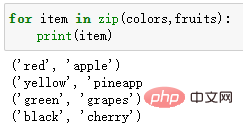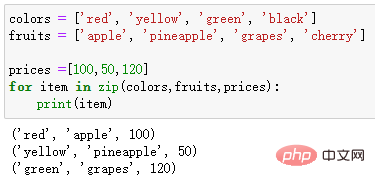 Backend Development
Backend Development
 Python Tutorial
Python Tutorial
 Introducing six super easy-to-use Python built-in functions
Introducing six super easy-to-use Python built-in functions
Introducing six super easy-to-use Python built-in functions
This article brings you relevant knowledge about python, which mainly introduces related issues about built-in functions. It mainly introduces six super easy-to-use functions, including Lambda, map , reduce, zip, filter, and enumerate functions. Let’s take a look at them together. I hope it will be helpful to everyone.

Recommended learning: python video tutorial
Lambda function
LambdaFunction usage Used to create anonymous functions, i.e. functions without names. It is just an expression, and the function body is much simpler than def. Anonymous functions are used when we need to create a function that performs a single operation and can be written in one line.
lambda [arg1 [,arg2,.....argn]]:expression
The body of lambda is an expression, not a code block. Only limited logic can be encapsulated in lambda expressions. For example:
lambda x: x+2
If we also want to call the function defined by def at any time, we can assign lambda function to such a function object.
add2 = lambda x: x+2add2(10)
Output result:

Using the Lambda function, the code can be simplified a lot. Here is another example.

As shown in the figure above, the result list newlist is generated with one line of code using the lambda function.
Map function
map()The function maps a function to all elements of an input list.
map(function,iterable)
For example, we first create a function to return an uppercase input word, and then apply this function to all elements in the list colors.
def makeupper(word): return word.upper()colors=['red','yellow','green','black']colors_uppercase=list(map(makeupper,colors))colors_uppercase
In addition, we can also use anonymous function lambda to cooperate with the map function, which can be more streamlined.
colors=['red','yellow','green','black']colors_uppercase=list(map(lambda x: x.upper(),colors))colors_uppercase
If we don’t use the Map function, we need to use a for loop.

As shown in the figure above, in actual use, the Map function will be 1.5 times faster than the for loop method of sequentially listing elements.
Reduce function
reduce() is a very useful function when you need to perform some calculations on a list and return the result. For example, when you need to calculate the product of all elements of a list of integers, you can use the reduce function. [1]
The biggest difference between it and the function is that the mapping function (function) in reduce() receives two parameters, while map receives one parameter.
reduce(function, iterable[, initializer])
Next we use an example to demonstrate the code execution process of reduce().
from functools import reducedef add(x, y) : # 两数相加 return x + y numbers = [1,2,3,4,5]sum1 = reduce(add, numbers) # 计算列表和
Get the resultsum1 = 15
We will see that reduce applies an addition function add() to a list [1 ,2,3,4,5], the mapping function receives two parameters, reduce()The result continues to be accumulated with the next element of the list.
In addition, we can also use anonymous function lambda to cooperate with the reduce function, which can be more streamlined.
from functools import reducenumbers = [1,2,3,4,5]sum2 = reduce(lambda x, y: x+y, numbers)
Get the outputsum2= 15, which is consistent with the previous result.
Note: Starting from Python 3.x,
reduce()has been moved to the functools module [2]. If we want to use it, we need to usefrom functools import reduceImport.
enumerate function
enumerate()The function is used to convert a traversable data object (such as a list, tuple or string ) are combined into an index sequence, listing data and data subscripts at the same time, generally used in for loops. Its syntax is as follows:
enumerate(iterable, start=0)
Its two parameters, one is a sequence, iterator or other object that supports iteration; the other is the starting position of the subscript, which starts from 0 by default, and can also be used since Defines the starting number of the counter.
colors = ['red', 'yellow', 'green', 'black']result = enumerate(colors)
If we have a color list that stores colors, we will get an enumerate object after running it. It can be used directly in a for loop or converted to a list. The specific usage is as follows.
for count, element in result:
print(f"迭代编号:{count},对应元素:{element}")
Zip function
zip()The function is used to take an iterable object as a parameter and add the corresponding elements in the object Pack it into tuples and return a list consisting of these tuples [3].
We still use two lists as an example demonstration:
colors = ['red', 'yellow', 'green', 'black']fruits = ['apple', 'pineapple', 'grapes', 'cherry']for item in zip(colors,fruits): print(item)
Output result:

When we use zip() function, if the number of elements of each iterator is inconsistent, the length of the returned list is the same as the shortest object.
prices =[100,50,120]for item in zip(colors,fruits,prices): print(item)

Filter 函数
filter()函数用于过滤序列,过滤掉不符合条件的元素,返回由符合条件元素组成的新列表,其语法如下所示[4]。
filter(function, iterable)
比如举个例子,我们可以先创建一个函数来检查单词是否为大写,然后使用filter()函数过滤出列表中的所有奇数:
def is_odd(n): return n % 2 == 1old_list = [1, 2, 3, 4, 5, 6, 7, 8, 9, 10] new_list = filter(is_odd, old_list)print(newlist)
输出结果:

今天分享的这6个内置函数,在使用 Python 进行数据分析或者其他复杂的自动化任务时非常方便。
推荐学习:python视频教程
The above is the detailed content of Introducing six super easy-to-use Python built-in functions. For more information, please follow other related articles on the PHP Chinese website!

Hot AI Tools

Undresser.AI Undress
AI-powered app for creating realistic nude photos

AI Clothes Remover
Online AI tool for removing clothes from photos.

Undress AI Tool
Undress images for free

Clothoff.io
AI clothes remover

AI Hentai Generator
Generate AI Hentai for free.

Hot Article

Hot Tools

Notepad++7.3.1
Easy-to-use and free code editor

SublimeText3 Chinese version
Chinese version, very easy to use

Zend Studio 13.0.1
Powerful PHP integrated development environment

Dreamweaver CS6
Visual web development tools

SublimeText3 Mac version
God-level code editing software (SublimeText3)

Hot Topics
 1382
1382
 52
52
 PHP and Python: Code Examples and Comparison
Apr 15, 2025 am 12:07 AM
PHP and Python: Code Examples and Comparison
Apr 15, 2025 am 12:07 AM
PHP and Python have their own advantages and disadvantages, and the choice depends on project needs and personal preferences. 1.PHP is suitable for rapid development and maintenance of large-scale web applications. 2. Python dominates the field of data science and machine learning.
 How is the GPU support for PyTorch on CentOS
Apr 14, 2025 pm 06:48 PM
How is the GPU support for PyTorch on CentOS
Apr 14, 2025 pm 06:48 PM
Enable PyTorch GPU acceleration on CentOS system requires the installation of CUDA, cuDNN and GPU versions of PyTorch. The following steps will guide you through the process: CUDA and cuDNN installation determine CUDA version compatibility: Use the nvidia-smi command to view the CUDA version supported by your NVIDIA graphics card. For example, your MX450 graphics card may support CUDA11.1 or higher. Download and install CUDAToolkit: Visit the official website of NVIDIACUDAToolkit and download and install the corresponding version according to the highest CUDA version supported by your graphics card. Install cuDNN library:
 Python vs. JavaScript: Community, Libraries, and Resources
Apr 15, 2025 am 12:16 AM
Python vs. JavaScript: Community, Libraries, and Resources
Apr 15, 2025 am 12:16 AM
Python and JavaScript have their own advantages and disadvantages in terms of community, libraries and resources. 1) The Python community is friendly and suitable for beginners, but the front-end development resources are not as rich as JavaScript. 2) Python is powerful in data science and machine learning libraries, while JavaScript is better in front-end development libraries and frameworks. 3) Both have rich learning resources, but Python is suitable for starting with official documents, while JavaScript is better with MDNWebDocs. The choice should be based on project needs and personal interests.
 Detailed explanation of docker principle
Apr 14, 2025 pm 11:57 PM
Detailed explanation of docker principle
Apr 14, 2025 pm 11:57 PM
Docker uses Linux kernel features to provide an efficient and isolated application running environment. Its working principle is as follows: 1. The mirror is used as a read-only template, which contains everything you need to run the application; 2. The Union File System (UnionFS) stacks multiple file systems, only storing the differences, saving space and speeding up; 3. The daemon manages the mirrors and containers, and the client uses them for interaction; 4. Namespaces and cgroups implement container isolation and resource limitations; 5. Multiple network modes support container interconnection. Only by understanding these core concepts can you better utilize Docker.
 MiniOpen Centos compatibility
Apr 14, 2025 pm 05:45 PM
MiniOpen Centos compatibility
Apr 14, 2025 pm 05:45 PM
MinIO Object Storage: High-performance deployment under CentOS system MinIO is a high-performance, distributed object storage system developed based on the Go language, compatible with AmazonS3. It supports a variety of client languages, including Java, Python, JavaScript, and Go. This article will briefly introduce the installation and compatibility of MinIO on CentOS systems. CentOS version compatibility MinIO has been verified on multiple CentOS versions, including but not limited to: CentOS7.9: Provides a complete installation guide covering cluster configuration, environment preparation, configuration file settings, disk partitioning, and MinI
 How to operate distributed training of PyTorch on CentOS
Apr 14, 2025 pm 06:36 PM
How to operate distributed training of PyTorch on CentOS
Apr 14, 2025 pm 06:36 PM
PyTorch distributed training on CentOS system requires the following steps: PyTorch installation: The premise is that Python and pip are installed in CentOS system. Depending on your CUDA version, get the appropriate installation command from the PyTorch official website. For CPU-only training, you can use the following command: pipinstalltorchtorchvisiontorchaudio If you need GPU support, make sure that the corresponding version of CUDA and cuDNN are installed and use the corresponding PyTorch version for installation. Distributed environment configuration: Distributed training usually requires multiple machines or single-machine multiple GPUs. Place
 How to choose the PyTorch version on CentOS
Apr 14, 2025 pm 06:51 PM
How to choose the PyTorch version on CentOS
Apr 14, 2025 pm 06:51 PM
When installing PyTorch on CentOS system, you need to carefully select the appropriate version and consider the following key factors: 1. System environment compatibility: Operating system: It is recommended to use CentOS7 or higher. CUDA and cuDNN:PyTorch version and CUDA version are closely related. For example, PyTorch1.9.0 requires CUDA11.1, while PyTorch2.0.1 requires CUDA11.3. The cuDNN version must also match the CUDA version. Before selecting the PyTorch version, be sure to confirm that compatible CUDA and cuDNN versions have been installed. Python version: PyTorch official branch
 How to install nginx in centos
Apr 14, 2025 pm 08:06 PM
How to install nginx in centos
Apr 14, 2025 pm 08:06 PM
CentOS Installing Nginx requires following the following steps: Installing dependencies such as development tools, pcre-devel, and openssl-devel. Download the Nginx source code package, unzip it and compile and install it, and specify the installation path as /usr/local/nginx. Create Nginx users and user groups and set permissions. Modify the configuration file nginx.conf, and configure the listening port and domain name/IP address. Start the Nginx service. Common errors need to be paid attention to, such as dependency issues, port conflicts, and configuration file errors. Performance optimization needs to be adjusted according to the specific situation, such as turning on cache and adjusting the number of worker processes.



